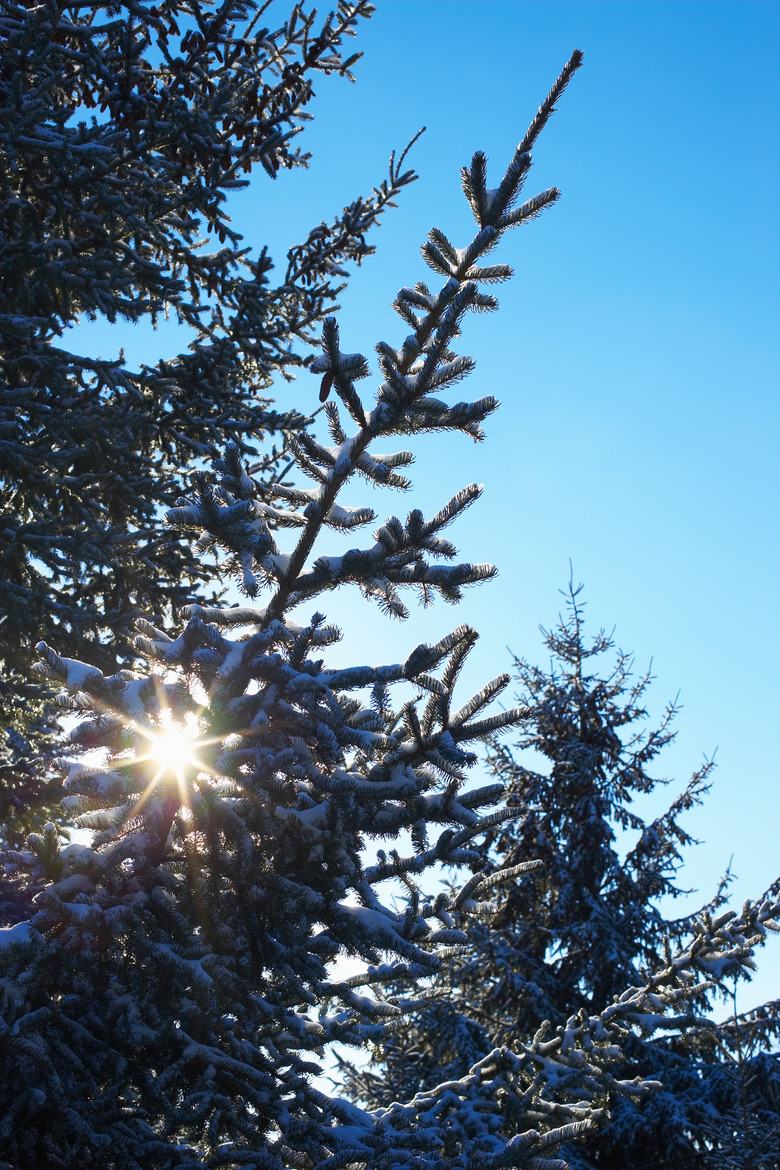Relationship Between Mistletoe And Spruce
The sight of a ragged "witches' broom" in a dark spruce in a snow-covered boreal wood can be arresting and even foreboding. Often this bundle of excess growth signifies a mortal symbiotic struggle between a small flowering plant called mistletoe and its conifer host.
Parasitism
Parasitism
The specific kind of symbiotic relationship exhibited between mistletoes and spruces is that of parasitism. In this situation, one organism – the parasite, here embodied by the mistletoe – gains benefit from another, while the latter is harmed by the interaction. Mistletoe is a seed-producing plant that extends fibers into the bark to draw out nutrients and water from the host tree. This tapping of the tree's resources can weaken it, making it more vulnerable to disease, drought, windthrow and other maladies. Most of the mistletoe's sustenance comes from parasitism, but the plant is capable of limited photosynthesis on its own. The seeds of mistletoe are sticky and "explode" from ripe fruit in late summer. They adhere to vegetation and, upon germinating, begin boring into their host.
Species
Species
A number of spruce species are regularly plagued by several kinds of mistletoe in North America. One of the most common relationships is that between black spruce and the eastern spruce dwarf mistletoe. Black spruce is a dominant tree in the continent's high latitudes, growing from the northern hardwood forests of the Midwest and Northeast through the taiga to the Arctic treeline. The same mistletoe can also infect white and red spruces, which share part of the black spruce's range. In the West, the Engelmann spruce and blue spruce of montane forests are vulnerable to the western spruce dwarf mistletoe as well as the lodgepole pine dwarf mistletoe.
Symptoms
Symptoms
Early symptoms of mistletoe infestation include abscessing in the area where the parasite's seed first punctures the host. Eventually buds may grow excessively in the vicinity, producing the mass of short, tangled twigs called witches' brooms. While a few other conditions may produce similar structures, the sight of a spruce canopy staggered with dark whorls of thick growth is often the clearest sign of mistletoe parasitism. Spruces with advanced infestation — supporting perhaps numerous mistletoes — often begin dying first in their unaffected branches, until most foliage resides within the brooms. Frequently, the crown of the spruce dies back early on, leaving a skeletal snag-head.
Ecology
Ecology
While mistletoe can be damaging or even lethal to the spruces it infects, the broader ecological influence is not always negative. For example, American martens — feisty, arboreal members of the weasel family that pursue squirrels, birds, snowshoe hares and other prey as well as snacking on berries — may den in the shelter of witches' brooms. There's a human angle, too: According to Adrian Tanner's 1979 ethnographic study of the Mistassini Cree Indians in northern Quebec, "Bringing Home Animals," the Cree traditionally incorporate a spruce's witches' broom — which they call "ciiwetinustikwaan," or "North man's head" — into their winter hunting magic. Such rituals involve actions such as burning witches' brooms to decrease ambient temperature, with an eye to improving hunting conditions.
References
- USDA Forest Service; Forest Insect and Disease Leafleft NA-PR-04-06 – Eastern Spruce Dwarf Mistletoe; F.A. Baker, et al.; 2006
- Colorado State University Extension; Mistletoes in Colorado Conifers; R.D. Koski, et al.; April 2009
- USDA Forest Service; Fire Effects Information System – Martes americana; Katharine Stone; 2010
- "Bringing Home Animals: Religious Ideology and Mode of Production of the Mistassini Cree Hunters"; Adrian Tanner; 1979

